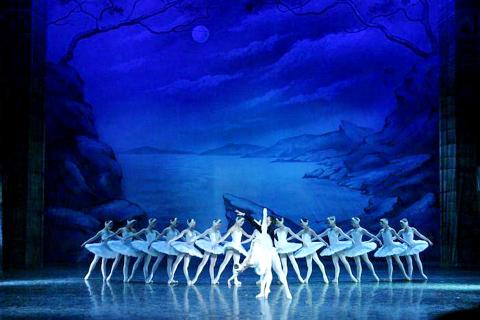The Moscow City Ballet’s swans have returned to Taipei for five shows at the National Theater.
At 27, the company is still a babe compared to its more famous Russian counterparts, the Mariinsky and Bolshoi ballet companies, but it has established a name for itself with competent, if somewhat stodgy, productions of the romantic classics, and its dancers come from state-runs schools in Russia and former Soviet states such as Ukraine.
The private company — a rarity in the Russian ballet world — was founded by former Bolshoi dancer-turned-choreographer Victor Smirnov-Golovanov, who died two years ago. His widow, Ludmila Nerubashenko, a former soloist with the company, is now artistic director.

Photo courtesy of moscow city ballet
The troupe’s strength is in its well-disciplined corps de ballet, crucial if you are sticking to the classics that need flocks of swans, Willies, village maidens or snowflakes who often have to perform two shows a day, as they will tomorrow and Sunday. The principal’s roles are often overshadowed by the mishmash of choreography they are expected to execute, combining the original Lev Ivanov-Marius Petip footwork with additions by Smirnov-Golovanov or other Russian choreographers.
One of the unique features of Smirnov-Golovanov’s production of Swan Lake is Odile’s half-black, half-white tutu that highlights the duality of her role, as she shows the white side to the prince, but the black to the audience.
Taiwanese ballet fans who cannot get enough of Swan Lake would appear to be in luck, as another frequent visitor to these shores, the Russian Festival Ballet, is coming next month with Swan Lake, The Nutcracker and Romeo and Juliet. However, the Moscow City Ballet’s production has better sets and staging.

Photo courtesy of mowcow city ballet
■ Tonight at 7:30pm, tomorrow at 2:30pm and 7:30pm and Sunday at 1pm and 6:30pm, National Theater (國家戲劇院), 21-1 Zhongshan S Rd, Taipei City (台北市中山南路21-1號)
■Tickets are NT$400 to 3,800, available online at www.kham.com.tw or at convenience store ticket kiosks

This is the year that the demographic crisis will begin to impact people’s lives. This will create pressures on treatment and hiring of foreigners. Regardless of whatever technological breakthroughs happen, the real value will come from digesting and productively applying existing technologies in new and creative ways. INTRODUCING BASIC SERVICES BREAKDOWNS At some point soon, we will begin to witness a breakdown in basic services. Initially, it will be limited and sporadic, but the frequency and newsworthiness of the incidents will only continue to accelerate dramatically in the coming years. Here in central Taiwan, many basic services are severely understaffed, and

Jan. 5 to Jan. 11 Of the more than 3,000km of sugar railway that once criss-crossed central and southern Taiwan, just 16.1km remain in operation today. By the time Dafydd Fell began photographing the network in earnest in 1994, it was already well past its heyday. The system had been significantly cut back, leaving behind abandoned stations, rusting rolling stock and crumbling facilities. This reduction continued during the five years of his documentation, adding urgency to his task. As passenger services had already ceased by then, Fell had to wait for the sugarcane harvest season each year, which typically ran from

It is a soulful folk song, filled with feeling and history: A love-stricken young man tells God about his hopes and dreams of happiness. Generations of Uighurs, the Turkic ethnic minority in China’s Xinjiang region, have played it at parties and weddings. But today, if they download it, play it or share it online, they risk ending up in prison. Besh pede, a popular Uighur folk ballad, is among dozens of Uighur-language songs that have been deemed “problematic” by Xinjiang authorities, according to a recording of a meeting held by police and other local officials in the historic city of Kashgar in

The People’s Republic of China (PRC) was out in force in the Taiwan Strait this week, threatening Taiwan with live-fire exercises, aircraft incursions and tedious claims to ownership. The reaction to the PRC’s blockade and decapitation strike exercises offer numerous lessons, if only we are willing to be taught. Reading the commentary on PRC behavior is like reading Bible interpretation across a range of Christian denominations: the text is recast to mean what the interpreter wants it to mean. Many PRC believers contended that the drills, obviously scheduled in advance, were aimed at the recent arms offer to Taiwan by the